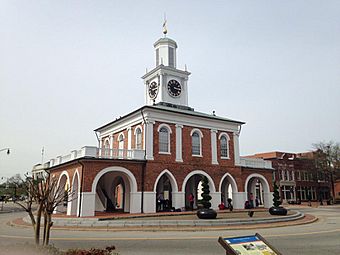Market House (Fayetteville, North Carolina) facts for kids
|
Market House
|
|
 |
|
| Location | Market Sq., Fayetteville, North Carolina |
|---|---|
| Area | less than one acre |
| Built | 1838 |
| NRHP reference No. | 70000451 |
Quick facts for kids Significant dates |
|
| Added to NRHP | September 15, 1970 |
| Designated NHL | November 7, 1973 |
The Market House is a special building in the middle of Fayetteville, Cumberland County, North Carolina. It served as both a market and a town hall.
This historic building was constructed in 1838. It stands where an older state house and town hall once were, which unfortunately burned down in 1831. For a short time, from 1789 to 1794, Fayetteville was even the capital city of North Carolina!
The Market House has an open ground floor with many arches, like a covered walkway. Above this, there's a large meeting hall. This style of building, called a market house, first became popular in places like the British Isles and is also seen in New England.
For many years, until the early 1900s, the Market House was a busy place where people bought and sold goods, and where town meetings were held. Today, it's recognized as a very important place and was named a National Historic Landmark in 1973. The top floor now has a museum where you can learn more about its history.
The Market House has a complex history. It was a central place for trade, and like many markets of its time, it was also a site where enslaved people were bought and sold. This part of its past is a difficult reminder of historical injustices. In May 2020, during protests, the building experienced some minor damage from a fire, which was quickly put out.
Contents
About the Market House
The Market House is easy to spot in downtown Fayetteville. It's right in the center where several streets meet: Green, Person, Gillespie, and Hay Streets.
Building Design
This two-story building is made of brick. The first floor is open with five large arches, creating a covered area. The second floor holds a big space that was once used for meetings.
The building has a sloped roof, and from the middle of the roof, a tall tower rises. This tower holds a bell and a clock. On top of the tower is a small, decorative dome called a cupola, with a weathervane pointing to the wind. The arches on the first floor are a mix of round and pointed shapes, all framed with stone. Some parts of the arched area stick out past the second floor, creating single-story sections with decorative railings on top.
Its Long History
The Market House was built in 1838. It replaced an earlier building that had been home to the state government from 1788 to 1793. That building was destroyed in a huge fire in 1831 that damaged many parts of Fayetteville.
The ground floor of the Market House was used as a market until 1907. The upper level served as the town hall until 1906. At one point, there was talk of tearing the building down. But a group of people stepped in to save it. They formed a private organization to help take care of the property. Now, the second floor is home to the Market House Museum. It often has special exhibits that change each month, focusing on different parts of the Market House's story.
Similar Buildings Around the World
The design of the Market House is similar to older market buildings found in Europe. For example, it looks a lot like market houses in places like South Shields, Stockton-on-Tees, and Abingdon-on-Thames in England. It also looks very much like the market house built in 1790 in Hillsborough, County Down, Northern Ireland.
Other famous buildings in the United States that served a similar purpose include Faneuil Hall in Boston, Massachusetts. Faneuil Hall also had an open, arched ground floor originally, before it was expanded in 1806. Another example is the City Market in Charleston, South Carolina, which still has its arched ground floor today. Both Faneuil Hall and the City Market are also recognized as National Historic Landmarks, just like the Market House in Fayetteville.
Images for kids
-
Marketplace in South Shields, England
-
1680 County Hall, Abingdon-on-Thames, England
-
1743 Faneuil Hall, Boston, as seen in 1789
-
St. Lawrence Market South, Toronto, Canada in 1899









